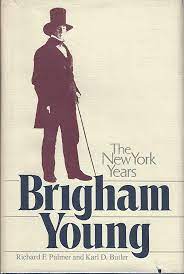Articles/Essays – Volume 16, No. 4
The Old Young Years | Richard F. Palmer and Karl D. Butler, Brigham Young: The New York Years
There is a distinct advantage in being a New Yorker when tracking one down in your own backyard. Richard Palmer’s second great-grandfather, Noah Palmer, came to Palmyra in 1810 and owned land adjacent to the Martin Harris farm on the west. Richard was born in Canadaigua and lived in Palmyra for the first twelve years of life. Currently a reporter for the Syracuse Herald Journal, he is a homebred Yorker with a recognized facility for local history, geography, and the vernacular to match. These pluses are of particular value when tracing Brigham Young and his kin through a patchwork of homesteads in western New York.
The Brigham pump was primed when Richard and his coauthor, Karl D. Butler were granted permission to republish a 66-page softbound work by Mary Van Sickle Wait, Brigham Young in Cayuga County, 1813-1829 (Ithaca, N.Y.: DeWitt Historical Society, 1964). Finding the account sketchy, lacking documentation and minus the Salt Lake City sources, they decided to start over. The New York Years is a product of more than a decade of in tensive research at ground zero plus a pair of summer sessions in the LDS Church Historical Department. Fortunately, its Brigham materials were simultaneously being catalogued and yielded bountifully.
In a majority of the Brigham Young accounts written thus far, the real Brigham doesn’t stand up until age thirty-one or thereabouts, already on his way across America with Joseph Smith. The pre-Church years are left in obscurity. But not now. A primary portion of the stimulating
text is concerned with the early life of Brigham Young and family members ending with Brigham’s conversion and a brief rehearsal of his earliest missionary labors to 1841. Thirty-one photos have been taste fully selected.
Of course, the authors use some of the standard sources, but happily a bevy of new facts emerge. They have been able to garner many local items which are often difficult for the hit-and-run historian to absorb. There are local histories, oral traditions, cemetery, and surrogate records, not to mention a familiarity with the lay of the land. A thorough knowledge of Brigham’s living at this site or that and his building this wing or that fireplace requires some prolonged and meticulous homework—at home.
The reader also comes away with a new recognition of the Young family structure. Numerous details concerning Brig ham’s brothers and sisters, their spouses, and their church affiliations add depth to the filial relationships extant in the expanded John Young, Sr., household. We have been exposed to Phinehas, Joseph and Lorenzo in previous encounters with the Youngs, but what of Abigail, Miriam, and Clarissa? New personalities begin to emerge for our inspection. It is difficult to know the whole Brigham until one be comes acquainted with those who inter acted so intimately with the man himself.
Similarly, Brigham Young’s religious experience prior to his exposure to Mor monism has been examined with insightful perspective. The authors have not strained to show him as being overreligious or underreligious in his search for the eternal.
I was also pleased to meet Brigham Young the carpenter, glazier, and painter. It was also interesting to meet Brigham Young the debtor. The authors affirm that he ultimately paid every debt, sometimes many years later. Despite his seemingly limitless capacity for work he was caught in the bill bind. The account of his determination to satisfy old creditors is a tribute to the tenacity for detailed research described in text by these writers. Palmer and Butler have unraveled fact from fiction to produce a chronology of Brigham’s places of employment and residences. They have also defused many myths of what Brigham actually made with his hands. It is a creditable job.
The comparative dearth of source documents for those initial years is the major problem. The authors acknowledged to me: “We only wish that there was more information. We just plain ran out of material to write about.” Wisely, they did not protract the volume beyond the available documents.
Although a number of writers have recently ploughed new ground on Brigham Young and more prospective contributors are poised in the wings, the Palmer-Butler volume is a refreshing and well-searched resource, the standard for the otherwise eclipsed era of the old Young years.
Brigham Young: The New York Years by Richard F. Palmer and Karl D. Butler (Provo, Utah: Charles Redd Center for Western Studies, 1982), 106 pp., $9.95.


 Back to full Issue
Back to full Issue

